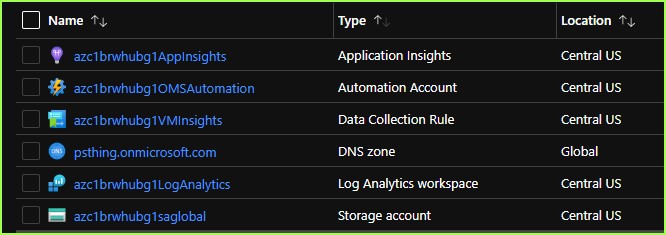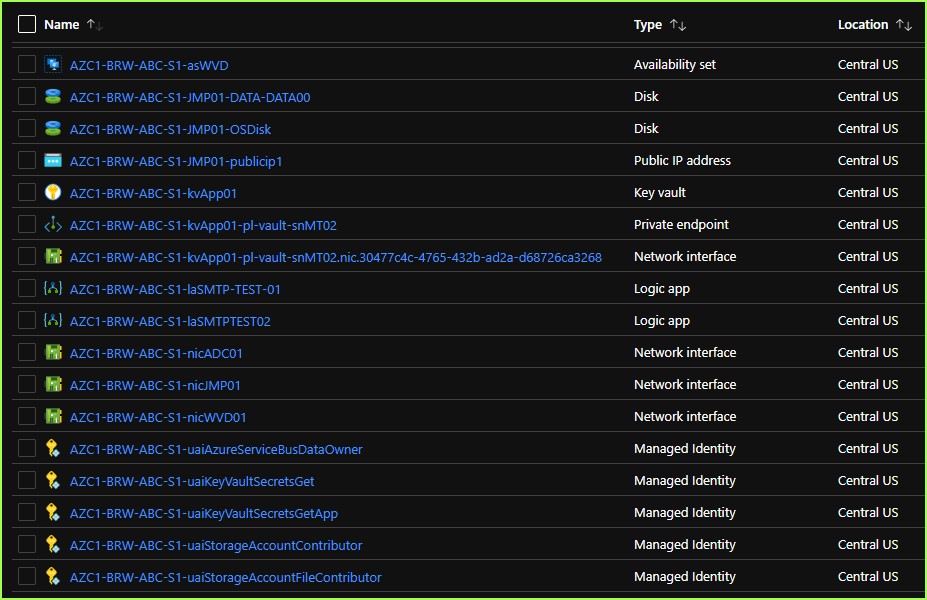Observations on ARM (Bicep) Templates
- Azure Deployment Framework
- Go Home Documentation Home
- Go Next Naming Standards Prefix
Naming Standards - These are configurable, however built into this project by design.
Azure Resource Group Deployment - Multi-Region/Multi-Tier Hub/Spoke Environments
Common naming standards/conventions/examples:
+ - ACU1-FAB-ADF-RG-S1
- [Central US Deployment for Fabrikam organization, for ADF App team Resource Group
Sandbox 1 RG]
+ - ACU1-FAB-ADF-S1-wafFW01
- [Central US Deployment for Fabrikam organization, for ADF App team, deploying a Web App.
Firewall in Sandbox 1 Resource Group]
! - The name that you provide: FW01
+ - ACU1-FAB-ADF-S1-vmSQL01
- [Central US Deployment for ADF App team,
deploying vmSQL01 Azure Virtual Machine in Sandbox 1 Resource Group]
! - The name that you provide: SQL01
+ - ACU1ADFS1SQL01
- [Central US Deployment (VM hostname on internal Domain [15 char limit]) for ADF App team,
deploying SQL01 VM in Sandbox 1 Resource Group]
! - The name that you provide: SQL01
- OrgName [FAB] is not included, since on internal domain and limit is 15 chars.
+ - ACU1-FAB-ADF-S1-nicSQL01
- [A Network interface on the above Virtual Machine]
- Generated from VM Name e.g. SQL01
+ - ACU1-FAB-ADF-S1-vn
- [A Virtual Network in the Sandbox 1 Resource Group - a Spoke Environment]
- Always 1 VNET per RG/Environment, also per Parameter file definition.
+ - ACU1-FAB-ADF-RG-S1
- [The Spoke Resource Group for Above (ADF App)]
+ - ACU1-FAB-HUB-RG-P0
- [The HUB Resource Group for HUB App]
+ - acu1fabhubg1saglobal
- [Central US Deployment for FAB organization, for HUB App team, deploying a storage account
(lower case 24 char limit) in Global (G1) Resource Group]
! - The name that you provide: global
+ - ACU1-FAB-HUB-P0-kvVLT01
- [Central US Deployment for FAB organization, for HUB App team, deploying a keyvault
in the HUB (P0) Resource Group]
! - The name that you provide: VLT01
+ - ACU1-FAB-HUB-P0-kvVLT01-pl-vault-snMT02.nic.50a08879-44ce-4a16-a9e9-8595ce9734ca
- [A private link connection on the above Keyvault to subnet MT02]
+ - ACU1-FAB-HUB-P0-networkwatcher
- [Network watcher on above HUB]
+ - ACU1-FAB-HUB-P0-networkwatcher/ACU1-FAB-ABC-S1-fl-AzureBastionSubnet
- [A Subnet from S1 Spoke Bastion Subnet connecting back to the Hub Network watcher]
| Name | Example | Allowed/Sample Values | Defintion |
|---|---|---|---|
| Example_Resource | ACU1-FAB-HUB-P0-kvVLT01 | ACU1-FAB-HUB-P0-kvVLT01 | A sample resource name used in this table Sample of a keyvault name |
| Prefix | {Prefix}-FAB-HUB-P0-kvVLT01 | AZE2 + ACU1 | Location - Azure Region (Using Azure Partner Regions) |
| DeploymentID | ACU1-FAB-HUB-P{DeploymentID}-kvVLT01 | 0 + 1 –> 8 00 + 01 –> 15 |
The deployment iterations (configured to 8 environments) The deployment iterations (configured to 16 environments) - Network ranges in Hub/Spoke are dynamically assigned based on this [DeploymentID] |
| Environment | ACU1-FAB-HUB-{Environment}0-kvVLT01 | S + D + T + Q + U + P | The specific environment type: [Sandbox –> Dev –> Test –> UAT –> QA –> Prod] |
| etype | Prod | PreProd + Prod | The general environment type |
| Enviro | ACU1-FAB-HUB-{Enviro}-kvVLT01 | D03 + T04 + Q06 + U08 + P09 + P00 S1 + D2 + D3 + T4 + U5 + P6 |
The environment name (16 environments) The environment name (8 environments) |
| OrgName | ACU1-{OrgName}-HUB-P0-kvVLT01 | FAB or ADW or WTP or FAB | Your 3 letter Organization (company) name. This ensures public Azure Resources have a unique name |
| App | ACU1-FAB-{App}-P0-kvVLT01 | ADF, HUB, PSO, ABC | The App (tenant) name |
| ResourcePrefix | ACU1-FAB-HUB-P0-{ResourcePrefix}VLT01 | kv,sa,vm,vmss,fw,waf,nsg | The resource type prefix e.g. kv |
| Name | ACU1-FAB-HUB-P0-kv{Name} | short name e.g. VLT01 | The resource name, this is the part that you define in the parameter file |
| Deployment | {Deployment}-kvVLT01 | ACU1FABADFS1 + ACU1-FAB-ADF-S1 + acu1fabadfs1 | Used for naming resources e.g. part of hostname and Azure Resource names, lower for storage Etc. [Prefix + App + Enviro] |
| Subscription | G0 | Azure Subscription Deployments G0 | E.g. RBAC or Policy |
| Global | G1 | A Global environment G1 represents Azure Global Services | E.g. DNS Zones or Traffic Manager OR GRS Storage |
| HUB | P0 | A Hub environment is denoted by the P0 or P00 | ACU1-FAB-ADF-P0 Central Hub, AZE2-FAB-ADF-P0 EastUS2 Hub |
| DR + HA | P0 or any other mirrored environment E.g. U4 or P6 |
Primary Test environment ACU1-FAB-ADF-T4 would have a mirror environment DR Test environment AZE2-FAB-ADF-T4 in the partner region |
A mirror would exist for a Test and Prod environments, Plus the associated HUB environment |
| * | ————————————————————- | * | ————————— |
How are the standard implemented?
The name of any resource is determined via the following method. - Example the Hub tenant, Central US Global Parameter File
- The Paremter File that you are deploying
- The parameter file defines a Resource Group
- This contains, the 3 parameters that automatically build the resource names.
- Prefix
- Environment
-
DeploymentID
"parameters": { "Prefix": { "value": "ACU1" }, "Environment": { "value": "G" }, "DeploymentID": { "value": "1" },
- Each template reads these values e.g. Storage Template
- The template combines the parts to create a Deployment Variable.
- Where appropriate the template also combines the parts to create a DeploymentURI Variable.
- This URI will be lower case a exclude any dashes Etc.
- This is used for URI’s and also things such as storage account names.
var Deployment = '${Prefix}-${Global.OrgName}-${Global.Appname}-${Environment}${DeploymentID}' var DeploymentURI = toLower('${Prefix}${Global.OrgName}${Global.Appname}${Environment}${DeploymentID}')
- Within the resources section any resource that is created uses the Deployment/DeploymentURI variable.
- The Deployment + the resource type prefix + the Resource short name.
- The Resource short name comes from the parameteter file for each enironment e.g. global
// a storage account resource SA 'Microsoft.Storage/storageAccounts@2021-06-01' = { name: toLower('${DeploymentURI}sa${storageInfo.name}') }
- The Resource short name comes from the parameteter file for each enironment e.g. global
// a virtual machine resource virtualMachine 'Microsoft.Compute/virtualMachines@2021-04-01' = { name: '${Deployment}-vm${AppServer.Name}' - The Deployment + the resource type prefix + the Resource short name.
- The Parameter File that you are deploying
- The parameter also contains individual resource definitions for that Resource Group
- Notice the name value above for ‘global’ comes from the parameter file as below.
"DeploymentInfo": { "value": { "saInfo": [ { "name": "global", "skuName": "Standard_RAGRS", "allNetworks": 1, "largeFileSharesState": "Disabled", "logging": { "r": 0, "w": 0, "d": 1 } } ] } }
- There is additional Global Metadata for each tenant (App Group)
- This is kept in the global file, so that it doesn’t have to be included in each individual parameter file
- This information will be static per App Group/Tenant.
"Global": { "hubSubscriptionID": "1f0713fe-9b12-4c8f-ab0c-26aba7aaa3e5", // Optional if different from current "OrgName": "PE", //<--- Change this to your unique 2 or 3 letter OrgName "AppName": "HUB", - The references to these can be seen above on the Deployment variable
- Global.OrgName
- Global.Appname
var Deployment = '${Prefix}-${Global.OrgName}-${Global.Appname}-${Environment}${DeploymentID}' var DeploymentURI = toLower('${Prefix}${Global.OrgName}${Global.Appname}${Environment}${DeploymentID}')
As a consumer of this project you are not responsible for managing naming standards/conventions.
- Naming standards are baked in, you only provide the short resource name.
- It is possible to change the default naming convention to meet your organizational needs
- I wouldn’t recommend it, however you would simply update the “Deployment” variable (shown above) to your new format.
Short Resource Name examples:
- global e.g. storage name
- SQL01 e.g. Virtual Machine Name
- App01 e.g. Keyvault Name
- FW01 e.g. Web Application Firewall Name
- I wouldn’t recommend it, however you would simply update the “Deployment” variable (shown above) to your new format.
Sample portal images based on this naming convention.
Sample - ResourceGroups

Sample - Global G1 Resource Group Resources

Sample - Spoke S1 Resource Group Resources
